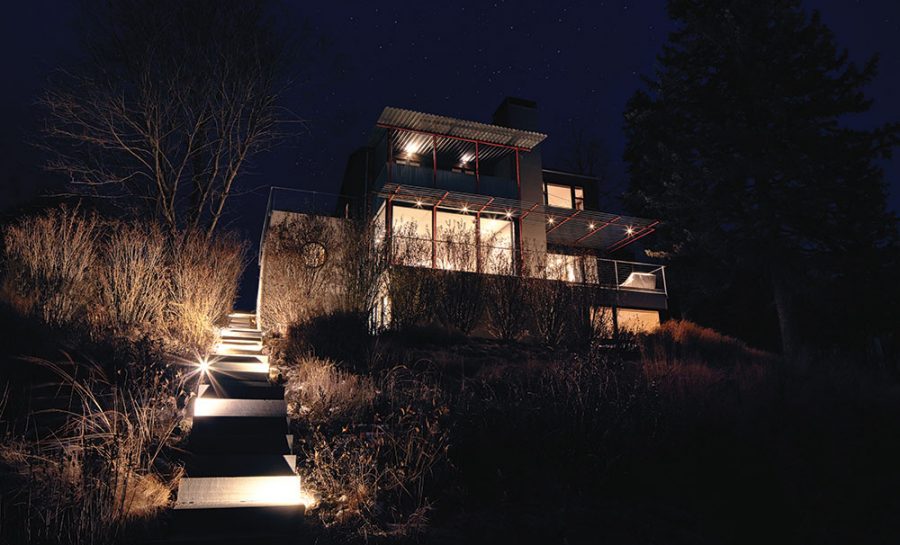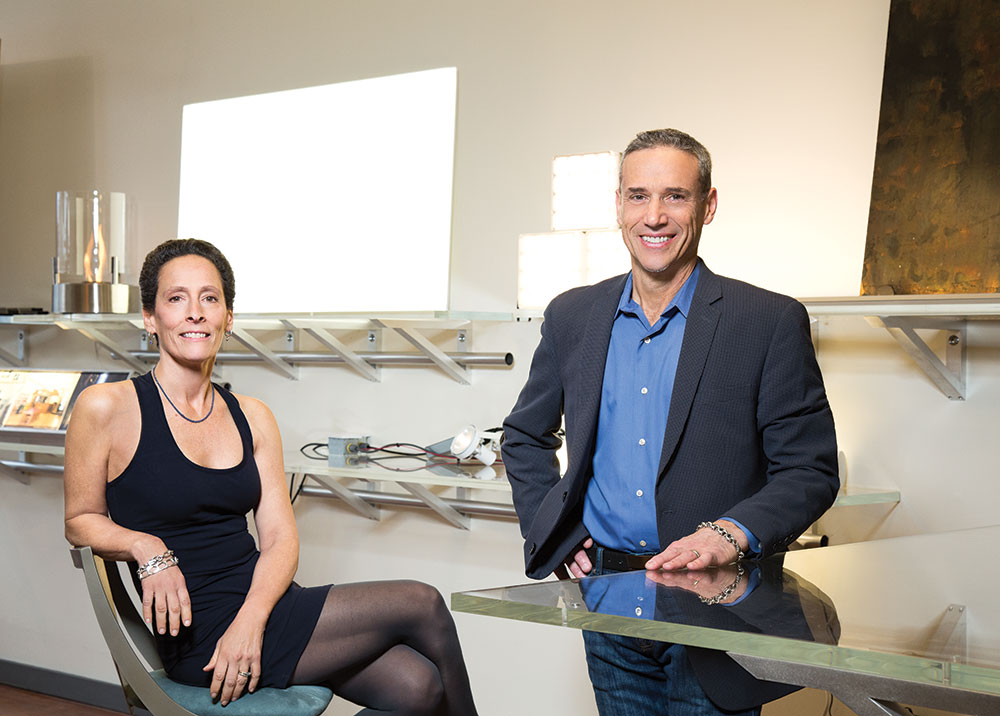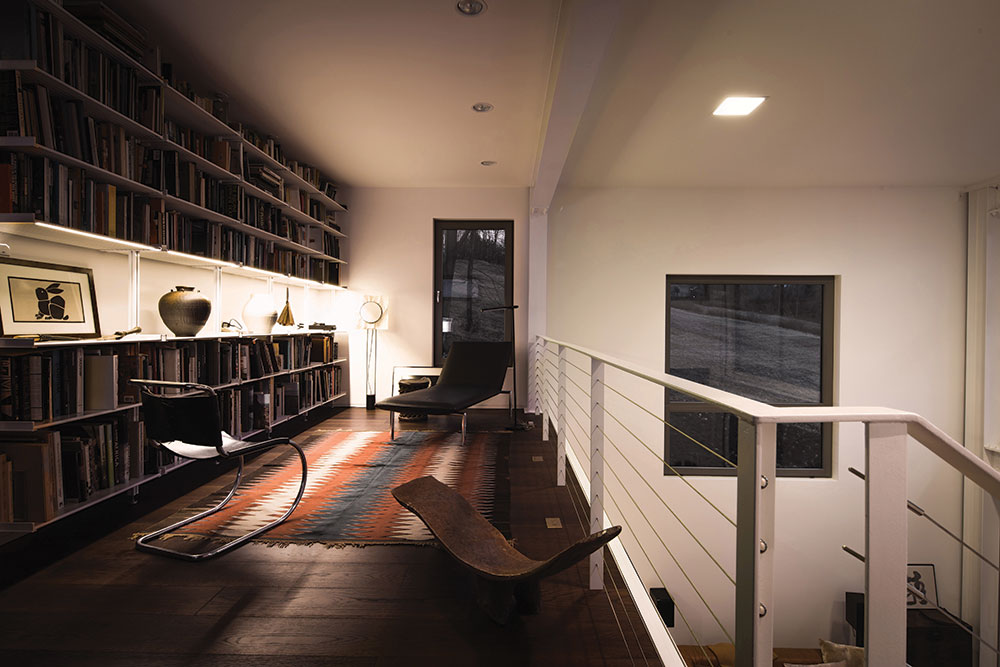Let There be Light Emitting Diodes
Energy Efficient Lighting Design
By Lynn Woods | Photos by Karen Pearson and David Aday | Spring 2017 | Features
Lighting completes a room’s design, illuminating its physical dimensions, emphasizing colors and textures, and creating points of focus and ambiance. And LED technology—a light-emitting diode, which consists of a two-wire semiconductor that releases photons when voltage is applied—both expands design possibilities and enables homeowners to cut energy costs. (After the refrigerator and dryer, lighting accounts for a home’s biggest use of electricity.) “We can do spectacular lighting in an energy-efficient way,” says Jeff Versakos, CEO of LEDspin, an LED lighting design firm. “Costs have come down, the quality is excellent, and you can wirelessly control the lights and dim them with your iPhone.”
Originally a designer of display cases for museums, aquariums, and other facilities, Versakos became obsessed with fixing a persistent problem: the damage to fragile artifacts, including paper and papyrus, as well as other not-so-delicate objects like gemstones and minerals, from heat caused by the lights used to illuminate them. He founded his display-case company, Band NY, Inc., in 1987, and began working with fiber optics in the 1990s. His system of projecting light through fibers to protect artifacts won him a contract with the federal government to illuminate the nation’s founding documents.
The Declaration of Independence, the US Constitution, and the Bill of Rights were slowly deteriorating after being displayed at the National Archives Building in Washington, DC, since 1952. After two years of R&D on the project, Versakos installed a fiber optics system, halting the damage. Band NY’s technology remains in place today, although its original halogen light bulbs have been replaced with LEDs.
Band NY has designed lighting systems for government institutions like the Library of Congress, the Smithsonian Institution, and the White House. The firm has also illuminated a collection of antique couture dresses at the De Young Museum in San Francisco, the exhibit of Tiffany windows at the Baltimore Museum of Art, artifacts at the National Baseball Hall of Fame in Cooperstown, and some of the world’s most precious documents, including the Magna Carta at the British Library in London and the Dead Sea Scrolls at the Israel Museum in Tel Aviv.


LEDspin was founded as a division of Band NY to offer LED lighting for homes, businesses, and museums. The company, which has an office in Rhinebeck and a showroom in Rhinecliff, services regional museums like the Home of Franklin Delano Roosevelt National Historic Site in Hyde Park, Boscobel House and Gardens in Philipstown, and Wilderstein Historic Site in Rhinebeck, but mostly caters to Hudson Valley and New York City homeowners.
LED lighting is the hope of the future, says Versakos, “a transformative technology that will help save the world from itself.” While incandescent light bulbs contribute to the emissions that cause climate change, LEDs are semi-conductors, akin to a computer, emitting a cool light that illuminates by glowing. Because there is no heat in their beams, LED bulbs are extremely efficient: A 7.5-watt LED bulb is equivalent to a 50-watt incandescent bulb. “In a one-to-one conversion to LED from incandescent or halogen bulbs, you’ll see, on average, a 60 percent drop in your energy bill,” says Versakos. An LED system costs more up front, he notes, but “the quality of light is as good if not better than older-style lamps, and if you do just a few rooms you’ll immediately have significant savings. We’ve got 13-watt lamps [that are] easily the equivalent of 75 watts, so you incredibly reduce the wattage costs.”
LED technology also keeps people safer from electrical fires, Versakos notes. LEDs can run off low-voltage 12-to-24-volt wires, compared with the standard 120 volts. In a media room he recently designed, both the LED light fixtures and the switches utilize low-voltage wiring. Someday, he says, “There will be wireless systems that use low voltage and one main room where the high voltage is.”
LEDspin offers an array of services to clients, from simply replacing existing lamps with LED lights to designing an elaborate system. However, Versakos notes, people often need to be educated about their options, including lighting an art collection by “washing” a wall with light while keeping the rest of the room muted, or “grazing” a stone wall with light to emphasize its texture. Some clients like to balance artificial light with daylight, a scheme that can include programming the lighting remotely.

For each lighting system, Versakos incorporates subtle color, choosing hues based on a room’s décor, furnishings, and wall texture and color. “There are different colors of white,” he says. “Some people like a warm light, or a light that’s somewhat whiter.”
LEDspin manufactures its own quality lighting fixtures for clients and offers a disk-shaped, voice-activated remote control device, The Dot; remote lighting systems can also be programmed from a cell phone. LEDspin also installs light switches with built-in transmitters, enabling clients to upgrade later to an automated system.
Outdoor lighting is another specialty. For a midcentury property in Woodstock, LEDspin lit a stainless steel outdoor pool by inserting lights into a set of 32-foot-long steps, and illuminated the bocce court and surrounding woods with high-intensity lights equivalent to daylight. Lights were also inserted under a woodshed’s eaves, between the rafters, to shelter them from precipitation.
A high IP, or Ingress Protection rating, is necessary for outdoor lighting, Versakos notes. This two-digit code indicates how well a device is protected from dust and water. An IP rating of 66, 67, or 68, achieved by testing a fixture by spraying it with water from a high-pressure hose (or, in the case of IP 68, actually submerging it), ensures the fixture will not be damaged by dirt, rain, ice, or snow.
For a plaza fronting a Holiday Inn Express in Midtown Manhattan, Versakos designed two rows of streetlights, in the form of spiraling tubes that are impervious to wind and rain. The fixtures cast a soft, white light akin to moonlight into the plaza, which also features lights inserted into the pavers.
As LEDspin’s client list grows, the company vows to remain small, “so we can maintain personal relationships with our clients,” notes Joanne Leffeld, Versakos’s wife and the firm’s president. Components for LEDspin’s products are manufactured overseas but assembled in the US, largely by Mid-Hudson Workshop, a business resource facility that employs physically and medically disabled veterans.
